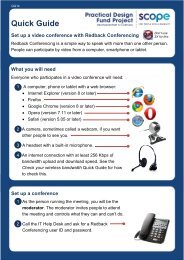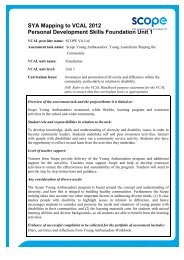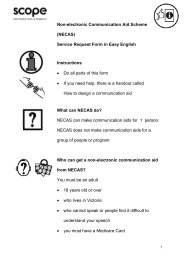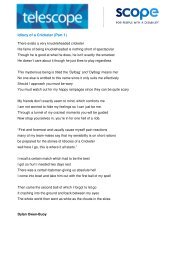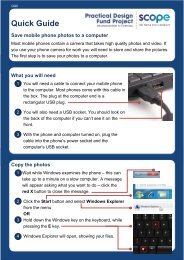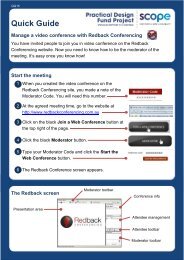Positive behaviour support Getting it right from the start
Positive behaviour support Getting it right from the start
Positive behaviour support Getting it right from the start
Create successful ePaper yourself
Turn your PDF publications into a flip-book with our unique Google optimized e-Paper software.
4 <strong>Pos<strong>it</strong>ive</strong> <strong>behaviour</strong> <strong>support</strong>: <strong>Getting</strong> <strong>it</strong> <strong>right</strong> <strong>from</strong> <strong>the</strong> <strong>start</strong> - Facil<strong>it</strong>ators reference manual<br />
The development of a <strong>behaviour</strong> <strong>support</strong> plan should involve <strong>the</strong> person w<strong>it</strong>h a disabil<strong>it</strong>y and<br />
those who know <strong>the</strong> person well. Of equal importance is ensuring that <strong>the</strong> <strong>behaviour</strong> <strong>support</strong><br />
plan is based on functional <strong>behaviour</strong> assessment conducted no more than five years ago.<br />
O<strong>the</strong>r highly relevant assessments include; communication skills, risk assessments, sensory<br />
assessments and neuropsychological assessments.<br />
The <strong>behaviour</strong> <strong>support</strong> plan must describe <strong>the</strong> use of <strong>the</strong> restrictive intervention. The inclusion<br />
of <strong>the</strong> restrictive intervention must be explained to <strong>the</strong> person w<strong>it</strong>h a disabil<strong>it</strong>y by an<br />
independent person.<br />
It is <strong>the</strong> role of <strong>the</strong> authorised program officer (APO) to approve <strong>the</strong> strategies in a <strong>behaviour</strong><br />
<strong>support</strong> plan before <strong>it</strong> is subm<strong>it</strong>ted to <strong>the</strong> senior pract<strong>it</strong>ioner.<br />
PowerPoint 8<br />
*<br />
Refer to <strong>the</strong> Office of <strong>the</strong> Senior Pract<strong>it</strong>ioner webs<strong>it</strong>e www.dhs.vic.gov.au/ds/osp for more<br />
information on:<br />
• role of <strong>the</strong> senior pract<strong>it</strong>ioner<br />
• restrictive interventions<br />
• Restrictive Intervention Data System<br />
• <strong>behaviour</strong> <strong>support</strong> plan<br />
• independent person<br />
• authorised program officer.<br />
Describe <strong>the</strong> difference between:<br />
• seclusion<br />
• mechanical restraint<br />
• chemical restraint<br />
• social restraint.<br />
Provide examples of each type of restraint.<br />
Seclusion – a room w<strong>it</strong>h a locked door/area and windows that <strong>the</strong> person cannot open<br />
<strong>from</strong> <strong>the</strong> inside<br />
1. a person in a wheel chair being moved into <strong>the</strong>ir bedroom against <strong>the</strong>ir will as a<br />
punishment for <strong>the</strong>ir <strong>behaviour</strong><br />
2. A person being moved into a room and <strong>the</strong> door shut and locked <strong>from</strong> <strong>the</strong> outside<br />
Mechanical restraint – device used to prevent, restrict or subdue a person’s movement,<br />
1. arm splints being used for non <strong>the</strong>rapeutic purposes<br />
2. being strapped into a chair as a method of <strong>behaviour</strong>al control<br />
Chemical restraint – medications used for <strong>the</strong> primary purpose of <strong>behaviour</strong>al control<br />
1. <strong>the</strong> use of valium or o<strong>the</strong>r drugs as a method of <strong>behaviour</strong>al control<br />
Social restraint – <strong>the</strong> use of verbal interactions, which might reasonably be construed by<br />
<strong>the</strong> person to whom <strong>the</strong>y are directed as intimidating or potentially abusive, which rely on<br />
elic<strong>it</strong>ing fear to moderate a person’s <strong>behaviour</strong>.




